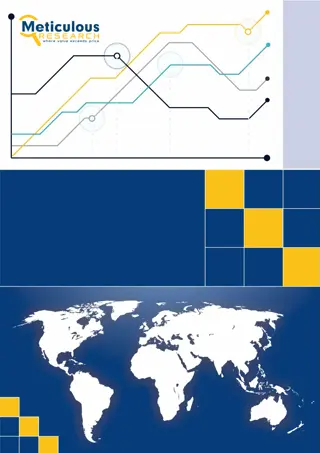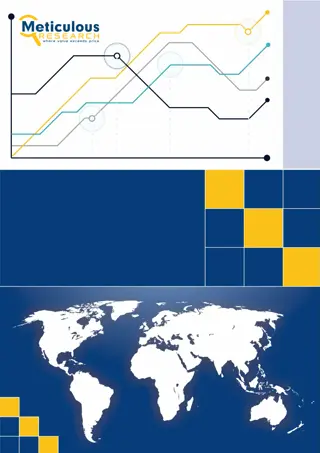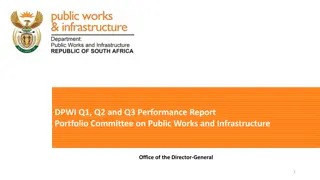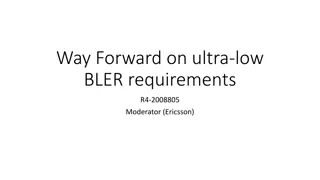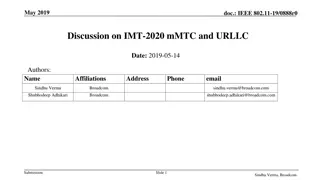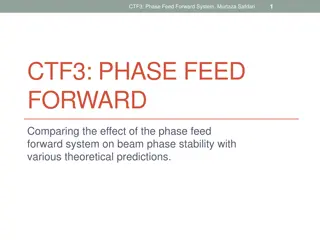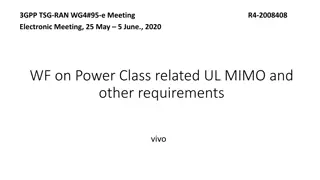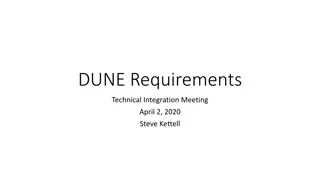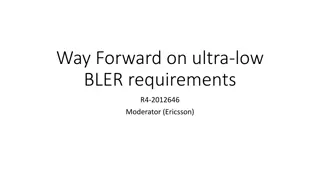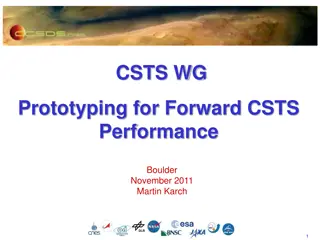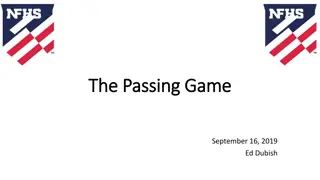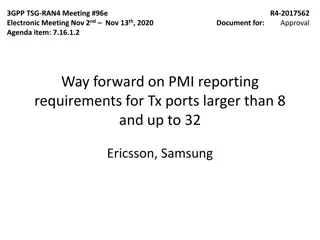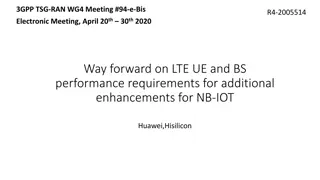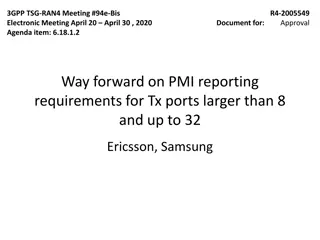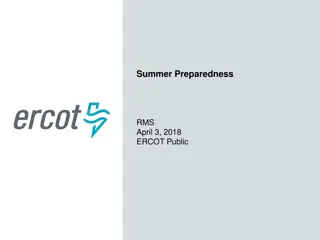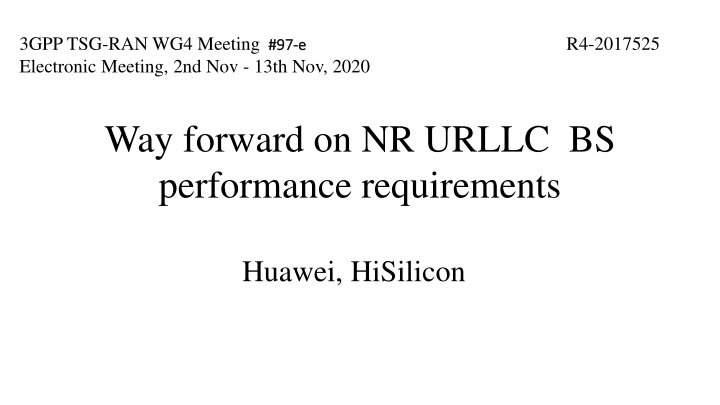
NR URLLC BS Performance Requirements Discussion at 3GPP TSG-RAN WG4 Meeting #97
"Explore the outcomes of the 3GPP TSG-RAN WG4 Meeting #97 regarding NR URLLC BS performance requirements, including approved workflows and agreements on demodulation, reliability, and safety considerations for 5G NR applications. Discover the testing methodologies, specifications, and applicability rules discussed by leading industry players. Stay informed on the latest developments in the evolution of next-generation communication standards." (Approximately 289 characters)
Download Presentation

Please find below an Image/Link to download the presentation.
The content on the website is provided AS IS for your information and personal use only. It may not be sold, licensed, or shared on other websites without obtaining consent from the author. If you encounter any issues during the download, it is possible that the publisher has removed the file from their server.
You are allowed to download the files provided on this website for personal or commercial use, subject to the condition that they are used lawfully. All files are the property of their respective owners.
The content on the website is provided AS IS for your information and personal use only. It may not be sold, licensed, or shared on other websites without obtaining consent from the author.
E N D
Presentation Transcript
3GPP TSG-RAN WG4 Meeting #97 Electronic Meeting, 2nd Nov - 13th Nov, 2020 R4-2017525 #97- -e e Way forward on NR URLLC BS performance requirements Huawei, HiSilicon
Background The following WFs were approved: R4-1915913: Way forward on NR URLLC demodulation and CSI requirements, RAN4 #93 R4-2002429: Way forward for NR BS URLLC performance requirements, RAN4 #94-e R4-2005528: Way forward for NR BS URLLC performance requirements, RAN4 #94bis-e R4-2008810: Way forward for NR BS URLLC performance requirements, RAN4 #95-e R4-2012649: Way forward for NR BS URLLC performance requirements, RAN4 #96-e
PUSCH PUSCH BS BS demodulation requirements of high demodulation requirements of high reliability: reliability: Agreements: Whether to clarify the safety statement in specification Agreement: capture following note in WF, not include into specification. ( no other companies show views on this topic till now except Huawei, Samsung, Nokia and E///). If the URLLC features of 5G NR would be used in safety or mission critical applications, the ultimately chosen statistical testing methodology for testing of these features must be verified by an independent body of experts/statisticians. It is also important to bear in mind that the demodulation requirements do not take account of all aspects of system operation (for example RF, transmitter, internal interfaces, higher layer protocol software etc.). BS demodulation requirements of high reliability for FR1 SNR values (dB) in specs (based on simulation results in R4-2015629): 15 kHz/5 MHz 15 kHz/10 MHz 30 kHz/10 MHz 30 kHz/40 MHz TS 38.104 Type A [-8.5] [-9.3] [-8.2] [-10.3] Type B [-8.2] [-9.8] [-8.2] [-10.2] TS 38.141 Type A [-7.9] [-8.7] [-7.6] [-9.7] Type B [-7.6] [-9.2] [-7.6] [-9.6] Applicability rule for FDD and TDD PUSCH aggregation factor for 15 kHz SCS: The requirements for PUSCH with aggregation for 15kHz can be tested either by configuring n8 and the DDDSU TDD pattern or by configuring FDD with aggregation level n2.
PUSCH PUSCH BS BS demodulation requirements of high demodulation requirements of high reliability: reliability: Agreements: BS demodulation requirements of high reliability for FR2 Waveform: CP-OFDM TDD pattern: DDDSU, S=10:2:2 Aggregation factor for TDD: n8 for DDDSU with note Note: The intention of this configuration is to have two effective transmissions of the transport block. To achieve this for the standard TDD pattern captured in this table, a value of n8 is necessary. Applicability rule for TDD with different UL-DL patterns: The same requirements are applicable to TDD with different UL-DL patterns and different aggregation factor configurations under assumption that two effective transmissions of the transport block are generated. Channel model: TDLA30-300 Low DM-RS: 1+1 HARQ process number: 4 RV sequence for 4 HARQ re-transmission: {0,3,0,3} with note Note: The effective RV sequence is {0,2,3,1} with slot aggregation SCS/BW: Both of 60 kHz and 120 kHz for both of 50 MHz and 100 MHz with applicability rule. Applicability rule: Only 1 SCS and 1 BW need to be tested based on the base station declaration and if there is no requirement for the declared BS bandwidth then the next lower requirement bandwidth is used. No PTRS
PUSCH PUSCH BS BS demodulation requirements of high demodulation requirements of high reliability: reliability: Simulation assumption for BS FR2 demodulation requirements of high reliability Parameter Value Disabled Transform precoding Both of 60 kHz and 120 KHz for both of 50 MHz and 100 MHz 60 kHz and 120kHz SCS: 3D1S1U, S=10D:2G:2U 1x2, Low 1 SCS/BW Uplink-downlink allocation for TDD (Note 1) Antenna configuration Number of layers Maximum number of HARQ transmissions 4 HARQ RV sequence DM-RS configuration type DM-RS duration Additional DM-RS position 0,3,0,3 (Note 2) 1 Single-symbol DM-RS Pos1 Number of DM-RS CDM group(s) without data 2 DM-RS -3 dB Ratio of PUSCH EPRE to DM-RS EPRE DM-RS port(s) DM-RS sequence generation PUSCH mapping type Starting symbol Allocation length PUSCH aggregation factor RB assignment Frequency hoping {0}, {0, 1} NID0=0, nSCID=0 B 0 10 n8 (Note 3) Full applicable test bandwidth Disabled Disabled TDLA30-300 Low Time domain resource assignment Frequency domain resource assignment Code block group based PUSCH transmission Propagation condition and correlation matrix Frequency density (KPT-RS) Disabled PT-RS configuration Time density (LPT-RS) Disabled Target BLER: 10-2 Testing metric (Calculate the target BLER after all transmission) Note 1: The same requirements are applicable to TDD with different UL-DL patterns and different aggregation factor configurations under assumption that two effective transmissions of the transport block are generated. Note 2: The effective RV sequence is {0,2,3,1} with slot aggregation
PUSCH PUSCH demodulation requirements for low demodulation requirements for low latency latency Agreements: FR1 URLLC demodulation requirements for PUSCH mapping Type B SNR values in specs (based on simulation results in R4-2015629) 15 kHz/5 MHz 15 kHz/10 MHz 30 kHz/10 MHz 30 kHz/40 MHz TS 38.104 [0.6] [0.2] [0.4] [-0.1] TS 38.141 [1.2] [0.8] [1.0] [0.5] FR2 URLLC demodulation requirements for PUSCH mapping Type B Waveform: CP-OFDM only Maximum HARQ re-transmission: 1 No PTRS SCS/BW: Both of 60 kHz and 120 kHz for both of 50 MHz and 100 MHz with applicability rule. Applicability rule: Only 1 SCS and 1 BW need to be tested based on the base station declaration and if there is no requirement for the declared BS bandwidth then the next lower requirement bandwidth is used.
PUSCH PUSCH demodulation requirements for low demodulation requirements for low latency for FR2 latency for FR2 BS FR2 URLLC demodulation requirements for PUSCH mapping Type B Symbol length Option 1: 2 Option 2: 4 Option 3: 7 DM-RS Option 1: 1+1 for symbol length of 7 Option 2: 1+0 for symbol length of 2 or 4 MCS Option 1: MCS5 from Table 3 Option 2: MCS10 from Table 3 Option 3: MCS6 for 4os or MCS4 for 7os Option 4: MCS5 for 4os or MCS10 for 2os
Simulation assumption for FR2 Simulation assumption for FR2 URLLC demodulation requirements for PUSCH mapping Type B URLLC demodulation requirements for PUSCH mapping Type B Parameter Value Transform precoding Disabled Both of 60 kHz and 120 KHz for both of 50 MHz and 100 MHz SCS/BW 60 kHz and 120kHz SCS: 3D1S1U, S=10D:2G:2U Uplink-downlink allocation for TDD Antenna configuration 1x2, Low Number of layers 1 MCS FFS 1 0 1 Maximum number of HARQ transmissions RV sequence DM-RS configuration type DM-RS duration Additional DM-RS position Number of DM-RS CDM group(s) without data Ratio of PUSCH EPRE to DM-RS EPRE HARQ Single-symbol DM-RS FFS 2 DM-RS -3 dB {0}, {0, 1} NID0=0, nSCID=0 B 0 2, 4 or 7 DM-RS port(s) DM-RS sequence generation PUSCH mapping type Starting symbol Allocation length Time domain resource assignment PUSCH aggregation factor 1 RB assignment Full applicable test bandwidth Frequency domain resource assignment Frequency hoping Disabled Disabled Code block group based PUSCH transmission TDLC300-100 Low Disabled Disabled Propagation condition and correlation matrix Frequency density (KPT-RS) Time density (LPT-RS) PT-RS configuration 70% maximum throughput Testing metric Note 1: The same requirements are applicable to TDD with different UL-DL patterns and different aggregation factor configurations under assumption that two effective transmissions of the transport
Rel Rel- -16 URLLC BS features 16 URLLC BS features Agreements: Whether to define performance requirements for PUSCH repetition type B Postpone the decision in next RAN4 meeting, and till Dec 2020 focused on Rel-15 test cases open issues. Whether to define performance requirements for Inter-UE multiplexing Agreement: Do not define the performance requirement for inter-UE multiplexing as no demodulation impact is expected.
PUSCH PUSCH demodulation requirements demodulation requirements CR work split CR work split Specifacation Requirements title CR Specifacation Frequency range CR work CR Responsibility BS demodulation (38.104/38.141- 1/38.141-2) FRC for all test cases 38.104 FR1 FRC Nokia FR2 FFS Samsung 38.141-1 FR1 FRC Ericsson 38.141-2 FR1 FRC Huawei FR2 FRC Samsung Test methodology 38.104? N/A Test methodology Nokia 38.141-1 N/A Test methodology Ericsson 38.141-2 N/A Test methodology Nokia/Huawei Test applicabilityfor all test cases 38.141-1 FR1 Test applicability Huawei 38.141-2 FR1 Test applicability Ericsson FR2 Test applicability Ericsson Requirements for PUSCH with ultra-lowBLER target (10-5) 38.104 FR1 Requirements Nokia FR2 FFS Samsung 38.141-1 FR1 Requirements/Measurement requirements Annex C.3 / Measurement system set-up Annex D of Performance Ericsson 38.141-2 FR1 Requirements requirementsAnnex C.3 / Measurement of Performance Ericsson FR2 N/A N/A Requirements for PUSCH with aggregationfactor configured 38.104 FR1 Requirements Huawei FR2 FFS Samsung 38.141-1 FR1 Requirements/Measurement requirements Annex C.3 / Measurement system set-up Annex D of Performance Huawei 38.141-2 FR1 Requirements requirementsAnnex C.3 / Measurement of Performance DoCoMo FR2 Requirements requirementsAnnex C.3 / Measurement of Performance Huawei Requirements mapping Type B with low number of symbols for PUSCH for 38.104 FR1 Requirements Nokia FR2 FFS Samsung 38.141-1 FR1 Requirements/Measurement requirements Annex C.3 / Measurement system set-up Annex D of Performance Huawei 38.141-2 FR1 Requirements requirementsAnnex C.3 / Measurement of Performance DoCoMo FR2 Requirements requirementsAnnex C.3 / Measurement of Performance Intel

